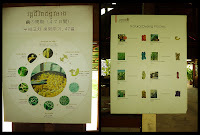 |
| Our 3rd day's tuk-tuk ride |
Finished our breakfast at the hotel's coffee shop, we still haven't decided what transportation to use, finally we contacted a tuk-tuk driver which my friend used his service when she came a week before our visit. Our itinerary for the day is the silk farm, Preah Kan, some other temples to visit as we pass and Angkor Wat as the last stop.
Silk Farm - Artisan Angkor
 |
| Artisan Angkor - mulberry garden |
It took around 30 minutes South from our hotel to reach the silk farm, it opens from 8 AM till 5 PM and there's a bus transfer from the Artisan Angkor main showroom at 9.30 AM and 1.30 PM. The first thing we saw as we reach there is the mulberry garden, the mulberry leafs are the food for the silk worm.
 |
| Information building |
We were greeted right away by the guide provided by the silk farm, they gave us a tour starting from information building.
 |
| House on stilts - to protect the silk worm from ants |
 |
| Insects breeding - egg and larva - small worm |
 |
| Silk worm & mulberry leafs |
 |
| Silk worm in cocoon |
Then to the place where they grew the silk worm from eggs to larva to little worms until it becomes large enough to build it's cocoon. Since the worm breeding is in a house of stilts, the below stilts are soaked in a bit of water to avoid ants to come in and attack the worms.
 |
| Cocoons & natural dyeing products used |
 |
| Extracting thread from the cocoon process & the remain of the silk worm |
 |
| Spinning and spooling silk thread process |
Then we were brought to the place where they collect the thread from the cocoon, the 1st layer is the thread to make raw silk and the 2nd layer is the thread to make silk, both has different texture. All of the product produced here is fully utilized : cocoon for the silk thread, silk worm to be consumed (local delicacy) mulberry leafs for the silk worm food and mulberry to be consumed by human. After dying the thread with natural coloring, they spin the thread manually or with a machine, then they combine from lots of spools of thread in same color to make it even layering by finely combing it with semi machine since this process still needs to be done by man (or woman to be exact).
 |
| Even layering process & motif covering process |
 |
| Final spooling fully motif covered thread |
 |
| Weaving process |
Afterwards we were brought to another chamber where they will process the even thread with motif by covering with plastics then dying the thread again and repeat the process until it follows the design from the designer, then the threads are spin again manually.
Then only after this process can the weaving start, it is said that the weaving is using the 2 on top and 2 below technique. It's really beautiful and this trip made me appreciate silk much more, to make one fabric can take 3-6 months for making starting from the egg stage depending on the level of difficulty of the making.
 |
| Exhibition room : old traditional equipment to make silk |
We were brought to their exhibition room which has collections of old traditional equipments to make silk, and there are examples of their traditional clothes made of silk as well. At the exit of the museum our guide informed that this is the end of our tour, the guide is free of charge by the company but tip is very much welcomed, especially they gave a very good tour and very patient in answering our questions. We were directed to the showroom but nobody there is pushing us to buy the goods, the cheapest scarf is USD 19 and it's on sale, I was thinking to buy it just for a memorabilia but then though that I would never use it since the size is really small and I'm not really fond with the color, so I just have to be content with the pictures taken there as my memorabilia :)
 |
| Exhibition Room : Traditional clothes made from silk |
Artisan Angkor itself was a join project with the European countries, to help rural living people to have jobs. This is why they welcome new students from the rural to learn the process for free so that they can be independent and start doing their specialization in their own area, and being part of the project itself. I think that this is a really good idea to empower the people.
I recommend to go to this place, especially if you are templed-out and it's worth seeing, unless you have been to a silk farm in other places.






















No comments:
Post a Comment